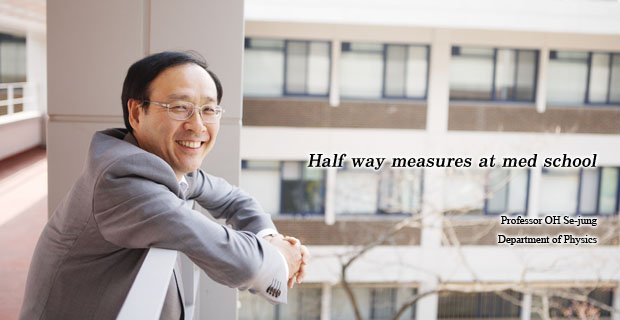
By OH Se-jung, Professor of Physics
Professor K of the Department of Life Science of the Korea Advanced Institute of Science and Technology is feeling down these days, not because he is having problems with research, but because he is having doubts about his students'education.
He has advised undergraduate students for the past four years with a goal of training the next academic generation, but only four out of his school's more than 60 departing undergraduates this yearadvanced to the KAIST graduate school. On top of that, students who were aiming to major in life science when they first entered the school are now feeling ambivalent as the watch their friends go on to medicine or dentistry.
Now, it seems as if the Department of Life Science is just a preparatory place for graduate schools in medicine and dentistry. The problem is that this situation is not just limited to the Department of Life Science in KAIST. Departments of life science at other prestigious universities in the country, including Seoul National University, are experiencing similar difficulties, and related departments such as chemistry or engineering have the same problems, if to a lesser degree, with the best students moving on to specialized graduate schools.
And this doesn't even mean that professors of specialized graduate schools of medicine are satisfied with these students. They expect students with diverse undergraduate backgrounds to contribute to innovative developments in the medical and biotechnology industries when their knowledge is tempered with medical education. But most students who enter these specialized graduate schools appear to be focused solely on opening their own practices and making piles of money.
Therefore, clinics are complaining that they cannot find doctors specializing in heart surgery or neurosurgery, and difficulties are increasing in research and education because students are not going into basic medical fields. In the end, it now takes two years longer to train clinical doctors who are not much different from doctors of the past, while tuition fees have been raised.
The introduction of a system that does not contribute much to the development of the medical and life science fields while interfering with the supply and demand chain for outstanding human resources in the science and engineering fields is largely due to the unilateral action of the Ministry of Education, Science and Technology.
The Ministry of Education attempted to convert all schools of medicine to the specialized graduate school system, under the justifications that Korea needs to train medical personnel at high standards and with worldclass expertise, and that it would ease the fierce competition of high school graduates to enter premedical courses.
It used all the carrots and sticks it had to force the change, including many privileges for medical schools converting to specialized graduate schools of medicine, and not permitting participation in the Brain Korea project for schools that did not convert.
As a result, many different types of medical schools have been mixed together in a deformed way, with 15 of the 41 medical schools in Korea converted to specialized graduate schools of medicine, 12 schools making a 50 percent conversion, and 14 schools remaining unchanged. Schools that have gone halfway down the new path in particular are stuck with a malformed academic system in which students take the same subjects in the same classrooms, but have to pay extremely divergent tuition fees while receiving different degrees- some get bachelor's degrees, while other receive specialized master's degrees.
Such irrationalities should quickly be eliminated to normalize the educational
system. If they are not, the problems in training medical doctors will grow worse, and supply and demand for science and engineering personnel could be damaged irreparably.
In actual fact, the two justifications the Ministry of Education used as it pursued a specialized medical graduate school system- that academic fusion was necessary for the development of the medical and biotechnology industries, which will be stimulated by training medical scientists with diverse backgrounds, and that the system will ease the university entrance competition for those aiming to enter premedical courses- have both been proven wrong now.
The reality is that the system is only creating the severe side effect of huge setbacks to the supply of science and engineering personnel, now that a large portion of science and engineering university graduates prepare for entry to specialized graduate schools.
What is to be done, then? The right thing to do would be to review the entire specialized medical graduate school system. However, with some universities having already converted into specialized medical schools and other students preparing for specialized medical graduate school, the fact is that it would be difficult to go back to the past system considering the blow it would deal to government credibility. However, universities that have only made a 50 percent conversion as a sort of test project and operate both undergraduate and specialized graduate schools should be given the choice to either go back to teaching undergraduate premedical courses or converting completely into specialized graduate schools according to their own judgment.
After all, the right thing is to leave the training to professors who are directly responsible for teaching new medical doctors instead of making decisions according to factors outside of education such as the university entrance competition. Only when a medical doctor training system is properly established will the science and engineering fields be able to devise long-term plans, too.

